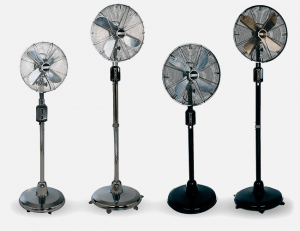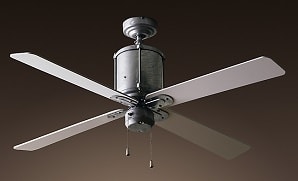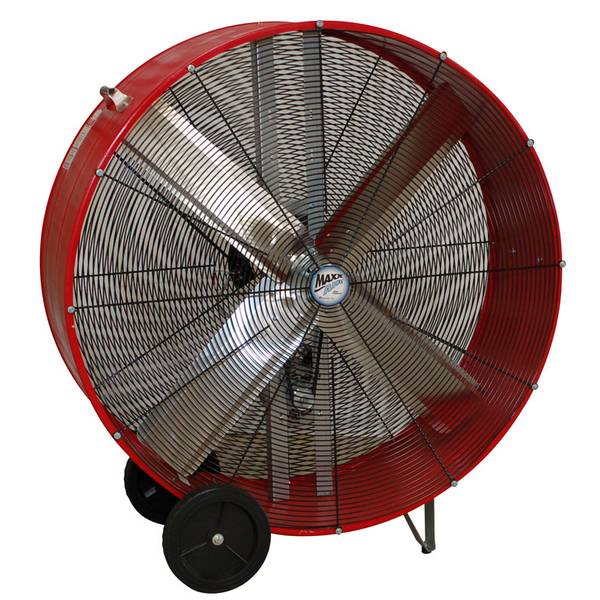
Barn Fans and Fire Alarms
Ceiling Fans | Wall Fans | Portable Fans | Misters | Fire Protection
 Safety
First - Barn Fires
Safety
First - Barn Fires
Electrical fires are a leading cause of preventable horse deaths, and it’s essential to prioritize safety when choosing equipment for barns and stables. All barns need fire alarms, barn roof wildfire ember protection, fire extinguishers, and/or interior automatic sprinklers to protect the animals and the structure.
Read Barn Fire Protection for a fast primer on protecting your structure and animals from smoke and fire.
Barn Fan Safety
When selecting fans for barns, consider the following factors to ensure safety:
- Industrial/Heavy Duty vs. Agricultural: Opt for fans specifically designed for agricultural use. Some industrial fans may not be suitable for dusty, humid, barn environments.
- Enclosed Motors: Choose fans with enclosed motors to prevent dust and debris from entering the motor. Over time, dust and debris build up on the fan motor, presenting a fire hazard. Less expensive fans tend not to have enclosed motors, so be careful when making your selection. The term "enclosed motor" will be indicated in the fan description.
- CFM (Cubic Feet per Minute): Consider the airflow capacity. More airflow is beneficial, but it’s essential to strike a balance.
- Oscillating Feature: If you prefer oscillating fans, ensure they can tilt as well. The tilting feature will be important when seeking to direct a fan downward or upward.
- UL Rating: Look for fans with UL (Underwriters Laboratories) ratings, which indicate compliance with safety standards.
Box Fans May be Dangerous
When choosing a fan, you want one that will be fitting for the size of your barn and will provide adequate airflow. However, not all fans are suited for use in a barn. Many boxed fans are not meant to be used in a barn since most box fans are designed for residential and light commercial use. Dust and hay can cause certain fans to short out if it reaches the motor and could even potentially cause a fire. Look for a fan with an enclosed motor and a long life span to alleviate the chance of fire. Recommended Stall Fan Use the CountyLine 18 in. Wall-Mount Barn Fan to get air moving in your barn summer or winter. The powerful direct-drive motor rapidly removes stale air and odors. With a tilting head and 3 speed modes to choose from, this heavy-duty fan is easy to use and reliable. It's crafted from powder-coat steel to ensure long-lasting quality and rust resistance.
Quality Barn Fans
Keep your livestock healthy and yourself comfortable during these periods of record heat. A good cooling system starts with quality barn fans that can cool the barn up to ten degrees. When selecting a fan for a stall, you will want one that can be mounted and has an airflow of around 2,000 – 3,000 cubic feet per minute (CFM).Also consider water misters in dryer climates where the evaporation of mist will cool the area another several degrees.
Removing Dust With Exhaust Fans
Exhaust fans serve the additional purpose of keeping air circulating and removing harmful hay dust and pollen. Airborne dust and pollen can negatively affect your animals as well as you. Dust also presents a safety issue with fans, so be sure to choose fans with an enclosed motor. Exhaust fans are especially effective in removing hot air and dust. Exhaust fans are especially important in winter for removing stale air and air born dust that accumulates in a closed environment..
Flying Insects are Controlled by Fans
A strong breeze from barn fans can significantly reduce flying insects by up to 80%, creating a less hospitable environment for pests and improving air circulation throughout the barn. Both livestock and barn people benefit from the lack of insects and the cooling breeze.
Fan Controllers
Universal Ceiling Fan Remote Control Kit, Hampton Bay. Fan Remote Kit Replacement for Hunter Fans, Harbor Breeze Fans, Home Decorators Fans. Featuring 3-Speed, Light Dimming, Time Delay. Now you can control your fan at any time including on/off, fan speed, and even dimming lights.
Barn Fans in Winter
- Air Quality Improvement: Barn fans circulate fresh air and expel stale, contaminated air, reducing harmful gases like ammonia and improving respiratory health for livestock.
- Humidity Control: Fans help dry out damp bedding and surfaces, preventing mold and bacterial growth that can cause respiratory and skin issues.
- Temperature Regulation: Though not heaters, barn fans distribute warm air evenly, reducing cold spots and condensation, and maintaining a consistent indoor climate.
Barn Ceiling Fans
 Large ceiling fans generate high levels of more indirect
air flow and assist in keeping the air flowing throughout
the barn.
These fans can also be reversed in winter to direct
rising warm air back down to the animals. Typically
these industrial fans are used in large warehouse
situations which make them perfect for all sizes of
barns. Click here
to see a huge selection of outdoor rated ceiling fans
suitable for your barn. Most come with remote controls
to make it easy to turn on or adjust speeds.
Large ceiling fans generate high levels of more indirect
air flow and assist in keeping the air flowing throughout
the barn.
These fans can also be reversed in winter to direct
rising warm air back down to the animals. Typically
these industrial fans are used in large warehouse
situations which make them perfect for all sizes of
barns. Click here
to see a huge selection of outdoor rated ceiling fans
suitable for your barn. Most come with remote controls
to make it easy to turn on or adjust speeds.
Barn Wall Fans
Quality Barn Wall Fans
Wall fans provide a sideways air flow and can be directed on the animals to help control flying insects. Large ceiling fans generate high levels of more indirect air flow and assist in keeping the air flowing throughout the barn. F A strong wall fan can keep several animals cool and free of flies, not to mention the comfort of farm hands working in the barn.
Floor Fans are Movable
Floor fans have the advantage of being portable and can be moved to different areas of the barn as needed. As with wall fans, some floor fans can be set to sweep back and forth to cover larger areas.
Drum Fans
 Drum fans provide powerful circulation whether in a
portable mode or as a highly efficient exhaust fan. Drum fans are a superior choice if you’re looking to produce strong, fast airflow. This type of fan is often used to cool livestock. Drum fans create a breeze strong enough to keep animals cool, calm, and comfortable.
Check out this large selection of quality drum fans in
all sizes and price ranges. You will find brand names
you will recognize for their quality and endurance such
as.
Drum fans provide powerful circulation whether in a
portable mode or as a highly efficient exhaust fan. Drum fans are a superior choice if you’re looking to produce strong, fast airflow. This type of fan is often used to cool livestock. Drum fans create a breeze strong enough to keep animals cool, calm, and comfortable.
Check out this large selection of quality drum fans in
all sizes and price ranges. You will find brand names
you will recognize for their quality and endurance such
as.
Barn Pedestal Fans
Maxx Air 30 in. pedestal fans can be adapted to a wide range of indoor environments with their heavy-duty metal construction and 3-speed PSC motor. Blow air across a barn to keep livestock cool and air circulating. Enclosed motor for safety and durability.
Misting Fans
Misting Fans Cool the Animals Skin and the Air Around Them
Misting fans have the two-fold benefit of providing a cooling mist, and as evaporation of the mist occurs, the air cools also. For livestock in enclosed areas, the refreshing mist keeps them less stressed and ultimately more productive.
Misting fans are available in portable or permanently fixed versions, and with and without water tanks. Those without tanks will require a source of water such as a horse bib.
Misting Wall Fans
Wall fans provide a sideways air flow and can be directed on the animals to help control flying insects. Wall fans can be set to sweep back and forth thus covering more space.
A strong wall fan can keep several animals cool and free of flies, not to mention the comfort of farm hands working in the barn.
Misting Floor Fans
Floor fans have the added advantage of being portable. Misting fans require a water supply which can mean hooking to a hose or choosing a fan with its own water supply in the form of a water tank. Misting fans are most suitable for dryer climates where evaporation will cool the animals.
Misting Fan with Water Tank
 This
fan is battery operated, making it super easy to use in
difficult areas.
Additionally, this high quality fan has its own wheels so it can be moved easily to
different locations as needed, and since it does not require a hose connection, moving does not require dealing with a water supply.
This
fan is battery operated, making it super easy to use in
difficult areas.
Additionally, this high quality fan has its own wheels so it can be moved easily to
different locations as needed, and since it does not require a hose connection, moving does not require dealing with a water supply.
Keep Barn Fans Clean
Keep Barn Fans Clean. Even though these fans are designed to hold up well in dusty environments, you still want to clean them regularly to expand their lifespan, as dust can build up. Blade cages can typically be opened, allowing you to wipe down the blades with a damp cloth. Fan filters can also be purchased to help prevent dust from entering the fan. Fan cleaning tools for easy overhead cleaning.
Natural Barn Ventilation
Stable Ventilation Best Practices
- Permanent Openings: Design barns with permanent openings to allow fresh air circulation. Ridge vents, breathable walls, and open stall partitions contribute to natural ventilation.
- Avoid Restrictions: Ensure that nothing obstructs the airflow through barn openings.
- Ridge Vent: Ridge openings along the roof ridge help hot air escape.
- Breathable Wall: Use materials that allow air exchange while maintaining structural integrity.
- Open Stall Partitions: Avoid solid partitions between stalls to allow air movement.
- No Ceiling: An open ceiling design facilitates airflow.
- No Overhead Hay/Bedding Storage: Avoid storing hay or bedding directly above the animals. Hay and bedding are extremely flammable and generate harmful dust.
- Thermal Protection: Fans should have thermal protection to prevent overheating. That means the fan turns off when reaching an overly hot temperature. The fan motors should be encased so flamable dust does not rest on the motor.
Questions? Comments? Advertise? Email the Webmaster: Equestrian Horse
Copyright 2025 EquestrianHorse.com